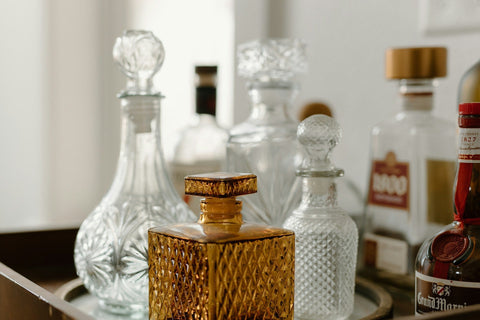When it comes to whiskey, aging is more than just a waiting game—it’s an art form that transforms raw distillate into a complex, flavorful spirit. The aging process, which takes place in wooden barrels, is one of the most critical factors in shaping whiskey's taste, aroma, and overall character. But how exactly does barrel aging influence whiskey flavor?
In this guide, we’ll explore the science behind barrel aging, the role of different types of barrels, and how factors such as time, temperature, and wood selection contribute to the rich, nuanced flavors of whiskey.

1. Why Whiskey Needs to Age
When whiskey is first distilled, it’s a clear, high-proof liquid known as “white dog” or “new make spirit.” While it contains alcohol, its flavor is harsh and unrefined. Aging in oak barrels allows the whiskey to mature, extracting flavors from the wood and undergoing chemical transformations that make it smoother and more complex.
The Main Goals of Barrel Aging:
✔ Mellowing the Harshness: Oak barrels help remove impurities and soften the spirit over time.
✔ Infusing Flavor: The wood imparts vanilla, caramel, spice, and smoky notes to the whiskey.
✔ Enhancing Complexity: Oxidation, evaporation, and chemical interactions all contribute to a richer taste.
✔ Color Development: The deep amber hues of whiskey come from tannins in the wood, not from any artificial coloring.
2. The Role of Oak Barrels in Whiskey Aging
Not all barrels are created equal! The type of oak used and how the barrels are treated significantly impact the final whiskey.
Types of Oak Used for Whiskey Aging:
-
American Oak (Quercus alba)
- Most commonly used for bourbon and Tennessee whiskey.
- Adds notes of vanilla, caramel, coconut, and spice.
- Stronger grain structure allows for deep flavor absorption.
-
European Oak (Quercus robur)
- Used in Scotch whisky and Irish whiskey aging.
- Produces bolder tannins with flavors of dried fruit, spice, and nuts.
-
Japanese Mizunara Oak
- Known for its rarity and expensive nature.
- Imparts unique flavors of sandalwood, incense, and coconut.
New vs. Used Barrels
- New Charred Oak Barrels (Required for bourbon) impart strong vanilla, caramel, and spice flavors.
- Used Barrels (Common in Scotch and Irish whiskey aging) offer subtler flavors, often with previous cask influences (e.g., sherry, wine, or rum barrels).
3. How Time Affects Whiskey Flavor
The longer whiskey stays in the barrel, the more it interacts with the wood and surrounding environment. But does aging always mean better whiskey?
How Aging Time Changes Flavor:
- 2-4 Years: Lighter flavors with prominent grain notes and soft vanilla hints.
- 5-10 Years: Balanced complexity with developed caramel, oak, and spice notes.
- 10-20+ Years: Deep, rich flavors with strong wood influence—can sometimes become over-oaked.
Some whiskeys, such as bourbon, often peak at around 8-12 years, while Scotch whiskies can age well for 15-30 years due to the cooler climate in Scotland, which slows maturation.
4. Environmental Factors That Influence Aging
Where a whiskey ages can be just as important as how long it ages.
Key Environmental Factors:
Temperature Fluctuations:
- Warmer climates (e.g., Kentucky, Tennessee) cause whiskey to expand and contract in the barrel more quickly, leading to faster flavor extraction.
- Cooler climates (e.g., Scotland, Ireland) allow for slower maturation, creating a smoother, more refined taste over time.
Warehouse Conditions:
- Barrels stored at the top of a rickhouse (warehouse) experience greater temperature swings and age faster than those at the bottom.
- Humidity levels also play a role in the evaporation of alcohol and water, affecting whiskey concentration.
Barrel Placement & Rotation:
- Some distilleries rotate barrels to ensure even aging, while others leave them stationary for unique flavor variations.
5. The Impact of Barrel Charring & Toasting
Before whiskey is poured into a barrel, the interior of the wood is either charred or toasted, which significantly affects the flavor profile.
Char Levels & Their Effects on Whiskey:
Light Char: Mild flavors with a focus on vanilla and floral notes.
Medium Char: Balanced caramel, spice, and smoky tones.
Heavy Char (Alligator Char): Strong oak, deep caramelization, and smoky richness.
Charring breaks down the wood’s sugars, creating flavors of toffee, brown sugar, and spice. This process is especially critical for bourbon, which legally must be aged in new charred oak barrels.
6. The “Angel’s Share” and Evaporation Loss
During aging, a portion of the whiskey naturally evaporates, known as the “Angel’s Share.” This loss can be anywhere from 2-10% per year, depending on climate and storage conditions.
Higher evaporation rates in warm climates lead to richer, more concentrated whiskey.
Lower evaporation rates in cooler climates result in smoother, longer-aged whiskey.
Distilleries account for this loss when pricing aged whiskey—longer-aged expressions cost more due to the reduced yield from each barrel.

Final Thoughts: The Art of Whiskey Aging
The aging process is one of the most crucial aspects of whiskey production, transforming raw distillate into a complex, flavorful spirit. From the choice of oak barrels to the climate in which they are stored, every element plays a role in shaping the final product.
Whether you enjoy the caramel-rich notes of bourbon, the smoky depth of Scotch, or the smooth finish of Irish whiskey, barrel aging is the key to unlocking whiskey’s incredible depth and character.
Looking for expertly aged whiskey? Visit Five Towns Wines & Liquors in New York to explore our selection of top-tier whiskeys from around the world. Our knowledgeable team is ready to help you find the perfect bottle for your collection.


